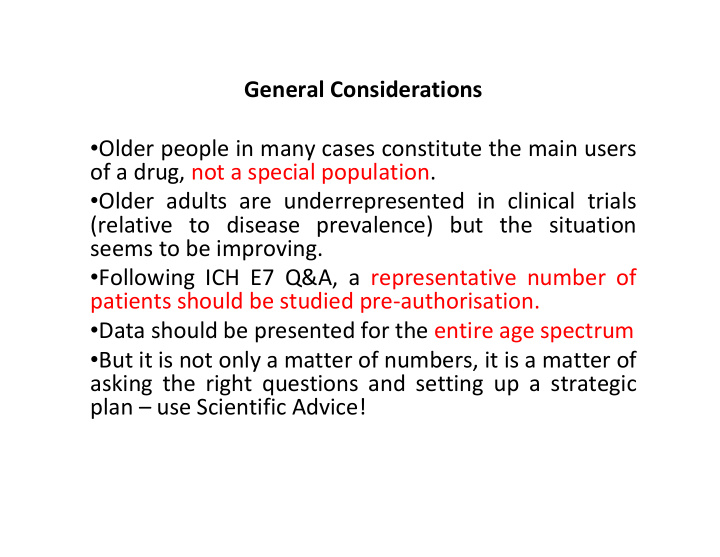



General Considerations • Older people in many cases constitute the main users of a drug, not a special population. • Older adults are underrepresented in clinical trials (relative to disease prevalence) but the situation seems to be improving. • Following ICH E7 Q&A, a representative number of patients should be studied pre-authorisation. • Data should be presented for the entire age spectrum • But it is not only a matter of numbers, it is a matter of asking the right questions and setting up a strategic plan – use Scientific Advice!
General Considerations (2) • There is a learning curve to gather data and modulate risk • Clinician often acts as gatekeeper in recruitment, and determines a selection bias by recruiting only some of the eligible patients • Population PK or specific PK study including the very elderly should be performed and will help informed prescription • M&S is powerful to identify patients at risk (efficacy and/or safety)
Endpoints - Considerations • Depending on frailty/disability the desirable outcome and treatment decisions might be different • Functional endpoints might be more relevant in certain cases (GEG input) • This may have HTA implications • Discuss in Scientific advice or parallel HTA/SA • Do we need to change the endpoints or the way we evaluate them?
Increasing recruitment - Considerations • Strategies and interventions to improve participation at level of ethic committees, recruitment process and trial conduct have been presented – Communication & Logistics – Make use of existing networks – Feed back the results – age exclusion should be justified, – commonly prescribed co-medication in this population should be allowed; – multimorbid patients should be allowed; – trial sponsor should provide support measures to encourage recruitment; – CT outcome measures should be relevant to old people.
Frailty and Older-old patients- Considerations • Consensus on Frailty definition and evaluation tools is needed (input from geriatric expert group GEG suggests SPPB) • More effort is needed to recruit patients 75+ in clinical trials: EFPIA survey shows preferred option is same clinical trial. Separate trial might be needed. • Accurate reflection of data in patients >75 years is important • EFPIA: comorbid patients should be in same Phase 3, However there is indication that a separate trial might be have better results in terms of recruitment • Data expected in the MAA, postmarketing will depend on target population- condition in RMP/Annex 2 • Sarcopenia is a worthwhile clinical endpoint per se (frailty is predictor of clinical outcomes + global societal benefit) • Heterogeneity can be in some measure allowed and analysed in clinical trial design both pre and post authorisation
Product information – Considerations • No good information is possible if there are no good data • Sometimes there is good information but not reflected • Channels of information are important- both to patient and prescriber • Better focus on Package leaflet • Specific measures are needed particularly as the older group is non homogeneous Better explain how to take medicine/increase compliance/PK and PD changes/concomitant medication • Consolidate in a comprehensive section? • information to Nurses should be allowed (?)
Formulations and Adherence – Considerations • Inappropriate formulations are conductive to low adherence and Safety and Efficacy problems • Multimorbidity/ dose reduction/ visual and mobility impairment needs to be considered when designing formulations • Issue probably more complex than paediatric due to variability in older population) • Protocols to evaluate the ability of patients to manage medication could be considered • QWP might take conclusions of workshop as starting points for a consultation on possible guideline on formulations (possible Q&A document) • Medication errors is an area where PRAC might seek QWP input • A Q&A on adherence aspects pertaining to Q/MI/PhV could be developed
Conclusions: how to strengthen pharmacovigilance • Risk management – based on the risk profile – plan to fill knowledge gaps through post-authorisation studies; targeted risk minimisation • Collection of data – optimise all possible data sources – facilitate reporting of suspected side effects, patient reporting; drug utilisation; electronic health records • Detecting new safety issues – huge potential to better use spontaneously reported adverse reactions: drug-drug and drug-disease interactions; focus on off-label use, medication errors, event clusters (e.g. falls dizziness);
Conclusions: how to strengthen pharmacovigilance 2 • Evaluation of safety issues – always consider the elderly • Benefit risk evaluation – dedicated consideration of elderly population; specific patient values placed on benefits and risks • Regulatory action – consider targeted action • Communications – meet the information needs of the elderly; support decision-making; target communication and risk minimisation
Conclusions: opportunities to move forward • New pharmacovigilance legislation – current consultations; dedicated new guidance; new tools (e.g. patient reporting) Regulatory sciences – methods for collecting data, • signal detection, bias and confounding in observational studies, novel clinical trial design, biomarkers • Resources : Research funding (IMI, Framework Programme etc); Accessing data; funding studies; expert staff; involving patients
Conclusion • We can further strengthen the protection and promotion of the health of the elderly, through a focus on the elderly in all aspects of regulation • ..and in partnership with all stakeholders
Next steps (1) • Report in one year on strategy impact as compared to baseline • CHMP will continue to consider older population in assessment • Reporting of results in regulatory documents will need to be improved • When drafted or revised, CHMP will consider strengthening existing disease specific guidelines, with particular regard to older-old, comorbidities, frailty
Next steps (2) • Pharmacovigilance activities, based in particular on new legislative tools • QWP might take conclusions of workshop as starting points for a consultation on possible Q&A on formulations • Frailty: need to agree on scale(s) for regulatory purpose • Internal EMA Processes to consider age- appropriateness of formulations, packaging are being developed (both in SA and MAA
Recommend
More recommend